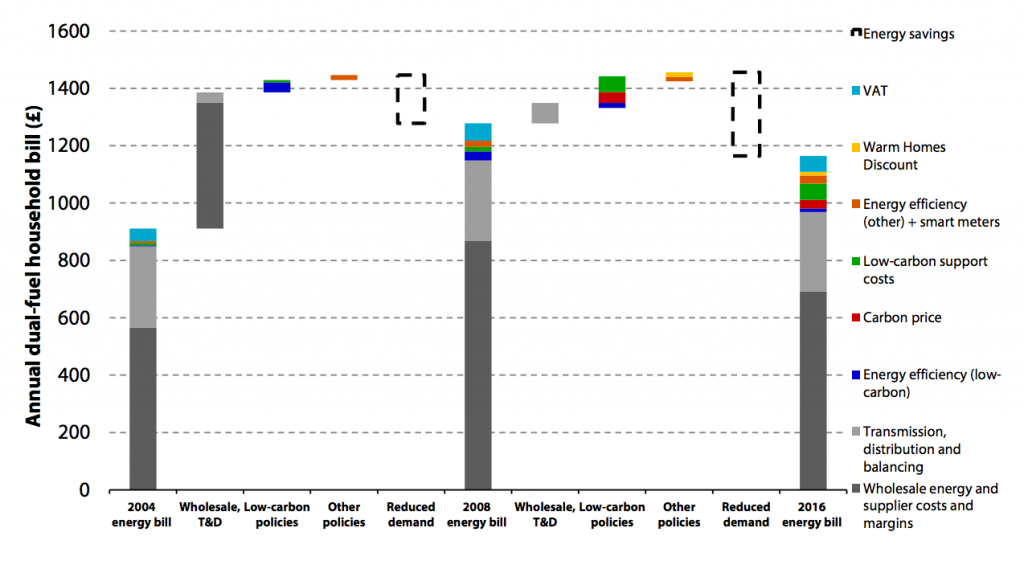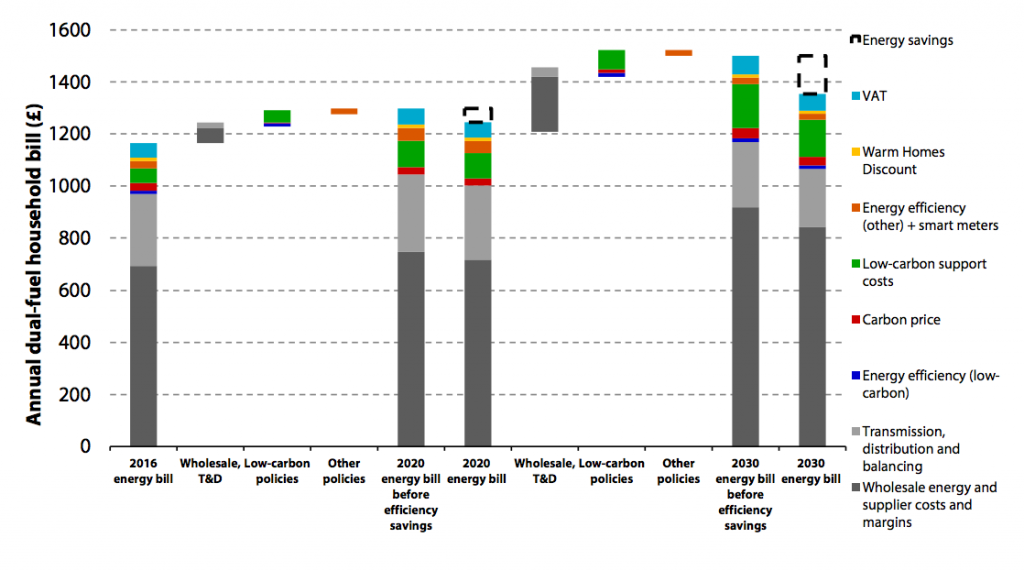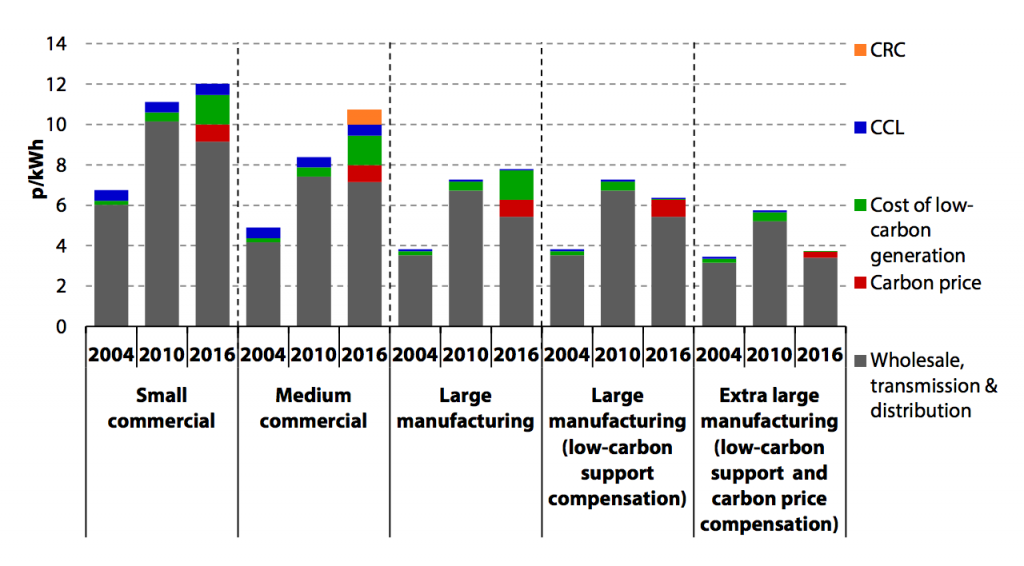
Household energy bills are lower today than they were when the UK began serious efforts to tackle climate change in 2008, according to new analysis.
Climate policy has helped cut bills by reducing demand, says the analysis from the Committee on Climate Change (CCC). At the same time CO2 emissions are down 28% since the Climate Change Act was passed and coal has all but swapped places with renewables in the UK electricity mix.
Policy costs are set to increase, the report says, but these costs could once again be more than offset by savings from using energy more efficiently. Wholesale energy and transmissions charges explain the higher costs faced by industry in the UK compared to other countries, the CCC adds.
Carbon Brief runs through the latest CCC report on energy prices and bills, which is published just hours before MPs prepare to debate the subject in parliament.
Energy bills
The debate over UK energy bills is back and climate policy is once again under the spotlight. Many utility firms have raised prices and several have blamed policy costs, despite figures from energy regulator Ofgem showing that rising wholesale prices are the most significant factor by far.
So today’s analysis of energy bills and prices, published by the CCC, is timely. Its headline finding is that, after adjusting for inflation, household bills in 2016 were lower than in 2008, the year the Climate Change Act became law. (Price rises prior to 2008 were caused by changes in wholesale gas costs, which were unrelated to climate policy).
In 2016, climate policy added £105 (9%) to the average dual-fuel household bill, the CCC says. This cost is shown in the red, green and blue bars in the chart, below, alongside VAT (light blue) and the costs of transmission, distribution, wholesale energy and supplier margins (grey).
Note that the CCC estimate of climate policy costs is “all inclusive”, as CCC chief executive Matthew Bell explained at a briefing with journalists.
This means it covers the direct cost of low-carbon subsidies, energy efficiency and carbon taxes, as well as indirect costs due to strengthening grids, backing up intermittent renewables, compensating conventional generation for lost revenue through the capacity market and savings due to the merit-order effect, which pushes down wholesale electricity prices.

Changes in average household energy bills between 2004, 2008 and 2016. The chart shows totals adjusted for inflation £(2016) and taking into account falling energy demand. Source: CCC.
As Carbon Brief noted earlier this year, household bills have fallen despite climate policy costs, because rising unit prices for each kilowatt hour of electricity or gas have been more than offset by falling demand, shown in the chart above with the dashed bars.
Since 2008, household consumption of gas is down by 23% and electricity by 17%, cutting the average bill by £290 and more than offsetting the increase in policy costs over the same period. As a result, it is misleading to present energy bill figures that assume constant demand.
These energy savings are largely the result of energy efficiency policies and regulations, from UK rules mandating more efficient condensing boilers to EU product policy on more efficient fridges and ovens. For more on this, Carbon Brief has a detailed look at falling domestic energy use.
At a briefing for journalists, Lord Deben, chair of the CCC, pushed back on the idea that the march of technological progress would have yielded these energy savings, even if climate policies were not in place. He said:
Why have we got European [energy efficiency] standards? Nobody would have got European standards if it wasn’t for the fact that we’re trying to fight a battle about climate change. If I tried to do this as a minister 10 years ago, I wouldn’t have got any of those standards…The fact is, these standards are being set in order to meet our climate change needs.
The fall in household bills in 2016 compared to 2008 appears to have filtered through to public opinion, even if it has not been reflected in a shift in media coverage. Long-running surveys carried out by the Department of Business, Energy and Industrial Strategy (BEIS) show the share of people worried about their energy bills is at its lowest recorded level.
Reminder: People in the UK are getting less and less worried about their energy bills (not that you’d know it from media) pic.twitter.com/35ryPUqYta
— Simon Evans (@DrSimEvans) February 16, 2017
Carbon targets
The CCC analysis shows how meeting UK climate goals would affect household energy bills in the years to 2030, when emissions are legally bound under the fifth carbon budget to be 57% below 1990 levels.
It says that climate policy costs are expected to add £200 to the average bill in 2030, an increase of £95 compared to 2016. It adds that, as in the years to 2016, this increase could be more than offset by energy efficiency savings worth £150-210, depending on future energy prices.
You can see these changes mapped out incrementally between 2016 and 2030 in the chart, below. Once again, rising climate policy costs should be more than offset by energy efficiency. The CCC expects bills to rise overall, if wholesale gas prices increase as expected in BEIS projections.
(These projections cover a range of increases from today’s price of 29p per therm, from 38p by 2030 at the low end up to 72p at the high end, with a central figure of 62p. It’s worth adding that government gas price projections have tended to be too high.)

Changes in average household energy bills between 2016, 2029 and 2030. The chart shows totals adjusted for inflation £(2016) and taking into account falling energy demand. Source: CCC.
As with past reductions in energy use, there is no guarantee that efficiency policies will actually deliver the savings expected by the CCC. Indeed, current low funding for energy efficiency means the savings are unlikely to materialise without a change of direction.
The CCC suggests 75% of those affected today could be lifted out of fuel poverty by 2030, if energy efficiency funding were doubled and directed towards fuel-poor households.
Though its analysis does not look beyond 2030 in detail, the committee says that low-carbon policy costs can be expected to fall in future, as renewable costs continue to fall and as the oldest subsidy contracts come to an end.
One intriguing aspect of the CCC analysis is that it highlights a gap in new electricity generation capacity, which must be filled in the 2020s if the UK is to have sufficient supplies. The gap amounts to around 45% of demand in 2030, and would be partially filled by the Hinkley C new nuclear plant.
The CCC’s calculations assume this gap is filled at an average cost of around £100 per megawatt hour (MWh), based on a “high renewables” scenario comprising only limited new nuclear capacity, a small amount of carbon capture and storage (CCS) and a mix of solar, onshore and offshore wind.
If more of the gap was filled with cheap renewables, such as onshore wind or solar, then the cost of meeting the UK’s 2030 targets could be reduced. For example, if an extra 10 percentage points of demand were met using onshore wind costing £60/MWh, then climate policy would add around £12 less to average household bills in 2030 (£188 instead of £200).
The CCC is “technology agnostic” as to how carbon targets are met. However, Mike Thompson, head of carbon budgets for the CCC, tells Carbon Brief that its new energy bill analysis was based on the high renewables scenario for 2030, because alternative “high nuclear” or “high CCS” scenarios “don’t look like the front runners”.
If the 2020s electricity generation gap is filled with gas-fired power stations facing a carbon price consistent with UK climate goals, then each household would save £20 per year, the CCC says.
If the gap was filled with gas facing no carbon price, the saving on bills would be larger, but UK climate targets would be at risk. Thompson tells Carbon Brief:
You can’t be serious about carbon targets and not be serious about a carbon price…The world we’re in is a world that cares about carbon. You can’t just bury your head in the sand and pretend you can just burn fossil fuels and not have to face any carbon price.
Industrial bills
A lengthy section of the new CCC analysis is devoted to energy bills for the UK’s commercial and industrial sectors. It concludes that climate policy is adding 3p to an average £10 basket of goods, with this rising to 6p in 2030. This represents a worst-case scenario, where 100% of costs are passed to consumers and no energy efficiency savings are found.
The impacts are more severe, the CCC says, when it comes to energy intensive manufacturing industries. These firms make up 2% of the UK economy, yet they are strategically and symbolically important, often employing large numbers at single sites.
For the most energy-intensive sectors, energy costs can account for nearly 4% of overall operating costs and 14% of gross value added. Many of these firms are offered compensation to offset the policy costs, yet low-carbon still make up 0.7% of total costs and 2.6% of value added, the CCC says.
It’s interesting to note that the larger energy users are able to buy electricity for much lower prices than those offered to households. For example, an extra-large manufacturing plant might pay less than 4p per kilowatt hour compared to consumer tariffs of more like 15p.

Business electricity prices in 2004, 2010 and 2016 according to type of company. CRC is the Carbon Reduction Commitment energy efficiency scheme. CCL is the Climate Change Levy. Source: CCC.
Despite receiving climate cost compensation, some industry groups have continued to lobby for policies to be scrapped, arguing that they are unfairly disadvantaged compared to their continental competitors.
CCC chair Lord Deben told journalists: “We think that what the government is doing in terms of offering compensation to [energy-intensive] industries is about right.”
Deben added:
We’re also opening the way to business opportunity. I think it’s worth, in these post-Brexit days, just remembering the fact that the energy efficiency [and] green part of the economy is now bigger than the coal, gas and oil industry. [It’s] bigger also than the heavy users of energy, and it’s growing, and it’s providing a lot of new jobs. So we should not just think about this in a Gradgrind way of adding up the figures…but also saying that it is the basis of the future, without which we are not going to be able to prosper.
A recent editorial in the Times said: “Representatives of heavy industries argue that the drive to shrink the national carbon footprint has been at their expense. There is some truth to this, but this country’s long-term economic health depends on knowledge-intensive rather than energy-intensive industries.”
The committee does not take such a stark view. Nevertheless, Bell makes it clear that change is inevitable. He tells Carbon Brief: “GDP in 2050 will look different to GDP in 1950. If the industrial strategy doesn’t prepare us for that change, then the UK will be worse off.”
Bell tells Carbon Brief:
Our analysis…doesn’t support the thesis that there’s been a lot of offshoring [relocation of industries from the UK to other countries] because of climate change policy. That’s very different from saying there’s been offshoring of manufacturing for a whole range of other reasons about relative wage rates, different tax treatments and all sorts of other things.
With the exception of the financial crisis, UK manufacturing has grown slowly but steadily, whist climate policies have been developing and having larger and larger presence on the landscape. If climate policies were driving the offshoring, you wouldn’t have expected to see that.
The CCC did extensive digging to try to understand the relative competitiveness impacts of climate policy on sectors including steel, cement and aluminium in the UK, Bell told a briefing for journalists.
He said:
The best that we can understand, the electricity costs for the steel sector are higher in the UK than elsewhere, but not because of climate policies. Other countries have more or less the same climate policies and have more or less the same costs and compensation levels accordingly. But, network costs and wholesale costs are higher here. We’ve also tried to understand why that’s the case…but that’s less clear. That’s why we’ve said that that should be clarified, because until there’s an explanation, the understandable default is to focus on climate policy.

